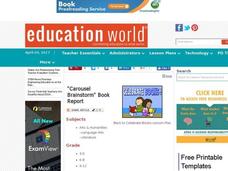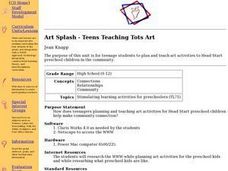Curated OER
Carousel Brainstorm Book Report
Students participate in a group review activity to analyze and discuss a book they have all read. They write a paragraph summarizing the findings related to one of the topics. Older students might summarize three topics or all the topics.
Curated OER
Tracking the Monster
High schoolers exchange fake bodily fluids with other students. They track the spread of the "infection" throughout the population of high schoolers and determine where the infection began in the class. Every student in the class...
Curated OER
Balobbyland City Planners
Students create a mini city using proportions that fit a model human they construct using tin foil. They plan the city including a library, sports arena, living spaces, parks and businesses. When constructing the paper buildings, they...
Curated OER
Alice Computer Programming
Students explore multimedia components. In this science inquiry lesson, students read "Invitation to the Game" by Monica Hughes and they use the Alice Computer Programming System to better understand population dynamics.
Curated OER
Estimating Solutions to Word Problems
Learners use estimation to determine the answers to word problems by rounding whole numbers. In this estimation lesson plan, pupils compare and contrast solutions using the best answer.
Curated OER
Multiplying Exponents vs. Powers of Powers
Use the power of a power property to solve exponential functions. The lesson refers to differentiating between multiplying or adding exponents to find the value, and how to find the product of a power of a power.
Curated OER
Teens Teaching Tots Art
High schoolers plan and teach art activities to Head Start preschool students in the community. High schoolers research the WWW while planning art activities for the preschool kids and while researching what preschool kids are...
Curated OER
Seed To Plant
Middle schoolers are introduced to alternative methods of growing techniques: specifically, hydroponics. They, in groups, "adopt" a seed. They take care of their seed and make observations as it begins to germinate.
Curated OER
Having Fun with Primary Sources
High schoolers analyze primary sources to determine the effects of the Great Depression on American society. They evaluate how government expanded during this time period because of New Deal legislation.
Curated OER
Polynomials
Students add and subtract polynomials. In this polynomials assessment, students calculate ten questions using addition and subtraction. Students use Lego manipulatives to create their own worksheet on polynomials.
Curated OER
The Civil War: Through the Eyes of Hoosier Women-
Fourth graders explain and analyze changes and interactions of Hoosier women in major social and work roles during the Civil War. They recognize and compare the contributions of both women on the home and war fronts.
Curated OER
Ancient China: Student Created Word Search Puzzles
Sixth graders classify and organize information about ancient China. In this Chinese history activity, 6th graders create word search puzzles and record the processes they used to create them.
Curated OER
Fiction vs. Nonfiction
Young scholars explore fiction and nonfiction writing. They identify the elements of fiction in a short story and identify the criteria necessary in a nonfiction piece. Students distinguish the author's purpose in an expository text,...
Curated OER
Zhu Zhu
Young scholars read an article about the toy Zhu Zhu and answer comprehension questions about it. In this toy lesson plan, students also create an ad for a new toy that they invent in groups.
Curated OER
Census Countdown
Students read and discuss the census and how the census is used by the government. In this census lesson plan, students use the data collected to compare different census's and their outcomes.
Curated OER
Geographic Information Systems (GIS) and Water Resources
Students demonstrate how water quality and environmental health issues can be analyzed together, how hydrologic information can be built up, and how decisions can be made using GIS.
Curated OER
Mammal Morphology: bats and people
In this mammals worksheet, students compare and contrast the physical characteristics of bats and people by filling out a chart. Students complete 17 rows in the chart and answer 3 short answer questions.
Curated OER
The Battle to Save Bats
Students investigate the disease that is causing the global decline of bats. In this animal health lesson, students read an article which discusses white-nose syndrome, the number one killer of bats. Students discuss ways to keep bats...
Curated OER
The Embodied Presidency
Eighth graders discover details about Thomas Jefferson's life. In this early American history instructional activity, 8th graders view a PowerPoint presentation that outlines some aspects of Jefferson's life. Students research the life...
Curated OER
Comparing Fairy Tales
Students read and review common fairy tales and come up with a list of characteristics from them. The Teacher models filling out either a compare & contrast graphic organizer comparing two fairy tales.
Curated OER
A WebQuest about Ocean
Fifth graders explore the realm of an ocean through an ocean WebQuest. The Problem Based Learning Theory is used within this lesson. They complete several activities on the different concepts of oceans. Students are challenged to solve...
Curated OER
Mending Walls: Barriers in Communications
Students explore a literal and figurative wall. In this communication lesson, students examine and discuss barriers in communication as they analyze Pink Floyd's "The Wall" and Robert Frost's "Mending Wall".
Curated OER
The Bill of Rights is a-Rockin
Young scholars explore the U.S. Constitution through music. In this Bill of Rights lesson, students discuss a hypothetical case regarding lyrics by Madonna and the historical Massachusetts Blue Laws. Young scholars use the Bill of Rights...
Curated OER
Feelings
Students learn how to express their feelings. For this language development lesson, one student reads a sentence off a sentence strip and another student responds with "I feel...". The class discusses why the student feels that way and...

























